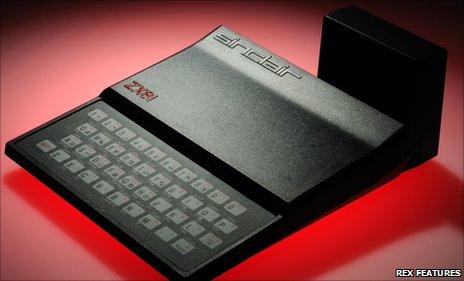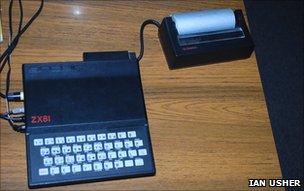ZX81: Small black box of computing desire
- Published
- comments

The Sinclair ZX81 was small, black with only 1K of memory, but 30 years ago it helped to spark a generation of programming wizards.
Packing a heady 1KB of RAM, you would have needed many, many thousands of them to run Word or iTunes, but the ZX81 changed everything.
It didn't do colour, it didn't do sound, it didn't sync with your trendy Swap Shop style telephone, it didn't even have an off switch. But it brought computers into the home, over a million of them, and created a generation of software developers.
Before, computers had been giant expensive machines used by corporations and scientists - today, they are tiny machines made by giant corporations, with the power to make the miraculous routine. But in the gap between the two stood the ZX81.
It wasn't a lot of good at saving your work - you had to record finished programming onto cassette tape and hope there was no tape warp. It wasn't even that good at keeping your work, at least if you had the 16K extension pack stuck precariously into the back.
One wobble and your day was wasted. But you didn't have to build it yourself, it looked reassuringly domestic, as if it would be happy sitting next to your stereo, and it sold in WH Smiths, for £69.95.
"It started off a proud tradition of teenage boys persuading their parents to buy them kit with the excuse that it was going to be educational," recalls Gordon Laing, editor of the late Personal Computer World and author of Digital Retro. "It was no use for school at all, but we persuaded our parents to do it, and then we just ended up playing games on them."
The ZX81 was a first taste of computing for many people who have made a career out of it. Richard Vanner, financial director of The Games Creators Ltd, is one.
"I was 14," he says, "and my brain was just ready to eat it up. There was this sense of 'Wow, where's this come from?' You couldn't imagine a computer in your own home.
The machine could get very hot, recalls Vanner.
"The flat keyboard was hot to type on. If you had an extension pack you had to hold it in place with Blu-Tack, because if it wobbled a bit you'd lose everything. You'd have to unplug the TV aerial, retune the TV, and then lie down on the floor to do a bit of coding. And then save it onto a tape and hope for the best.
"But because it was so addictive, you didn't mind all these issues."
Many a teenaged would-be programmer spent hours poring over screeds of code in magazines.

The thermal printer was loaded with a shiny toilet roll
"It would take hours and hours to type in, and if you made just one mistake - which might have been a typing error in the magazine - it didn't work," says Laing.
"Also there was the thermal printer for it, with shiny four-inch paper like till receipts, and as soon as you got your fingers on it you could wipe it off. One fan site described it as 'a rather evil sort of toilet roll'."
In fact, the very limitations of the ZX81 are what built a generation of British software makers. Offering the ultimate in user-frostiness, it forced kids to get to grips with its workings.
"I taught myself to program with the manual," says Vanner, "which was quite difficult. It was trial and error, but I got things working. Then magazines started to come out, and there we were, game-making with 1K."
That lack of memory, similarly, was a spur to creativity.
"Because you had to squeeze the most out of it," says Vanner, "it forced you to be inventive. Someone wrote a chess game. How do you do chess with 1024 bytes? Well the screen itself took up a certain amount of memory, so they loaded the graphics onto the screen from the tape. There was no programme for that, but people got round these things with tricks."
Some feel that the amount of memory on today's computers can make programmers lazy and profligate. Sir Clive Sinclair himself told the Guardian last year: "Our machines were lean and efficient. The sad thing is that today's computers totally abuse their memory - totally wasteful, you have to wait for the damn things to boot up, just appalling designs. Absolute mess! So dreadful it's heartbreaking."
The name combined the two most futuristic letters in the alphabet with a number that rooted it in the present day - though that doesn't seem to have been particularly deliberate. The designer Rick Dickinson says they named its predecessor, the previous year's ZX80, after its processor, the Zilog Z80, with an added X for "the mystery ingredient".
Dickinson visited Dixons to consider which existing products it should look like, he says. "But I don't know that I came up with any answers. Most of this stuff was just blundering through, and hitting on something that just seemed right.
"We wanted it to be small, black and elegantly sculpted. Beyond that the main thing was the cost, so the keyboard had just three parts compared to hundreds today. And some keys had six or even seven functions, so there was the graphics exercise of getting that amount of data onto the keypad.
But why it so captured the public imagination, Dickinson finds hard to say.
"They liked the design of it, and they liked the price, but beyond that you'd have to ask a psychologist. It created its own market.
"No-one knew they wanted a computer. It was just the right product, at the right time, at the right price."